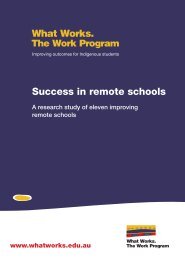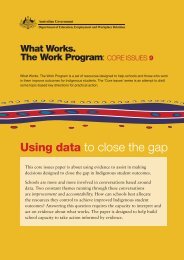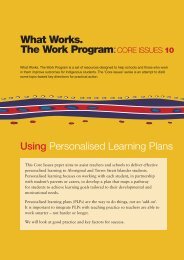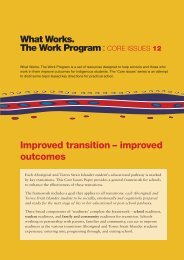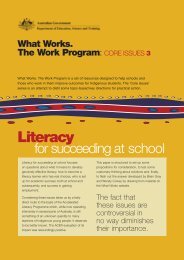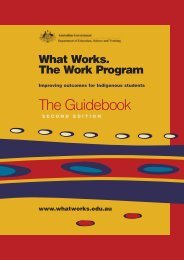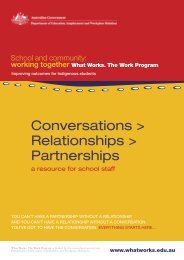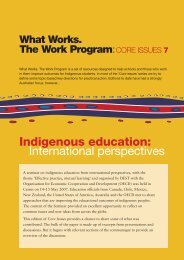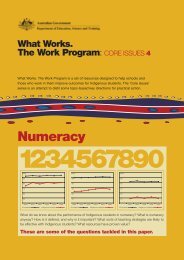Bound for Success Scope and Sequence Statements
Bound for Success Scope and Sequence Statements
Bound for Success Scope and Sequence Statements
- No tags were found...
You also want an ePaper? Increase the reach of your titles
YUMPU automatically turns print PDFs into web optimized ePapers that Google loves.
SCIENCEEarth <strong>and</strong> BeyondConcept In Year 1the student:In Year 2the student:In Year 3the student:In Year 4the student:In Year 5the student:In Year 6the student:In Year 7the student:In Year 8the student:In Year 9the student:Forces on Earth<strong>and</strong> BeyondThe earth is made upof materials that arealtered by <strong>for</strong>ceswithin it <strong>and</strong> on itssurfaceSustainability of lifedepends on the qualityof the air <strong>and</strong> theavailability of water<strong>and</strong> materials fromthe ground• Knows the differentobservable features of thenatural environment (e.g.hills, plains, valleys,bushl<strong>and</strong>, wind, clouds,sun, rain, desert, beach)<strong>and</strong> identifies the naturalfeatures within <strong>and</strong> aroundthe school. SS• Knows the differentcomponents of the naturalenvironment (e.g. soil,rocks, shells, water, air)<strong>and</strong> where they are (ierocks <strong>and</strong> soils make upthe ground, air is all round<strong>and</strong> water is found in theoceans, rivers <strong>and</strong> creeks).• Knows that differencesexist between differenttypes of rocks, soils <strong>and</strong>water (ie can compare <strong>and</strong>say that two rocks aredifferent or the same orthat two soils are differentor the same).• Knows that theenvironment can changefrom day to day <strong>and</strong> fromnight to night (e.g. says“yesterday it was raining<strong>and</strong> today it is sunny” <strong>and</strong>“you can’t see the sunanymore but I can see themoon <strong>and</strong> the stars”).• Makes simple statementsto describe how werespond to changes in theweather (e.g. says “when itis cold I wear a jumper” or“we will probably eatdinner outside tonightbecause it is hot”).• Knows that things in thenatural environment occurtogether (e.g. draws apicture of the beach <strong>and</strong>includes shells, s<strong>and</strong>,water). A• Identifies features of theschool environment thatare natural (not made byman) <strong>and</strong> man-made. SS• Investigates which soilmakes the best s<strong>and</strong> castles<strong>and</strong> speculates about why(e.g. says “this soil feelslike powder <strong>and</strong> is dry <strong>and</strong>red but this soil is grainy<strong>and</strong> feels wet <strong>and</strong> isbrown”).• Identifies parts of ournatural environment weneed to survive (e.g. says“we need water to stayalive”).• Knows that the sun isresponsible <strong>for</strong> shadows<strong>and</strong> that they can ‘make’their own shadow.• Knows that that the airchanges in terms of smell,movement <strong>and</strong> clarity (e.g.says “the air is smoky <strong>and</strong>it’s really still”).• Recognises that differentaspects of the environment(temperature, clouds,wind, sun, visibility) canchange in different waysover a 24 hour period <strong>and</strong>that they can predict thesedepending on the season<strong>and</strong> sometimes the time ofday (e.g. says “it’s reallyhot <strong>and</strong> windy today but itwas cold <strong>and</strong> still lastweek”).• Describes the majorfeatures of their own localenvironment, such asbushl<strong>and</strong>, trees, beachl<strong>and</strong>,swamps or wetl<strong>and</strong>s,hills, valleys, rocky areas,gardens <strong>and</strong> ovals, <strong>and</strong>knows that a variety ofdifferent environmentsincluding snow-l<strong>and</strong>s <strong>and</strong>deserts exist beyond thelocal environment.• Sorts <strong>and</strong> classifies parts oftheir local environment asnatural or man-made <strong>and</strong>says why (e.g. says “roadsare made by men becausethey clear a path”). SS• Recognises that differenttypes of soils exist <strong>and</strong> cansay which types are best<strong>for</strong> different common uses(e.g. says “beach s<strong>and</strong> isnot good <strong>for</strong> buildingcubby houses because itcollapses”).• Collects data showing howthe weather (temperature,rainfall, cloud cover <strong>and</strong>wind speed) changes overa week <strong>and</strong> comments onwhat it shows. N• Describes the effects of thewind, sun <strong>and</strong> rain on theenvironment.• Describes changes on theEarth, recognising thatsome are predictable as aresult of patterns (e.g.says “rain comes from low,black clouds so it doesn’tusually rain when cloudsare high <strong>and</strong> white”).• Begins to underst<strong>and</strong> theways in which they <strong>and</strong>other living things dependon the Earth <strong>and</strong> areaffected by its changes.• Knows that environmental<strong>for</strong>ces or changes canaffect other parts of theenvironment (e.g. the windaffects waves <strong>and</strong> rain;wind moves dirt <strong>and</strong> s<strong>and</strong>;temperature <strong>and</strong> rainaffects water supply,sunlight affect plantgrowth).• Knows <strong>and</strong> describes waysthat we respond to the• Describes the differenttypes of environments intheir community <strong>and</strong>surrounding region (e.g.says “a swamp is muddy<strong>and</strong> has lots of long grass<strong>and</strong> frogs” or “a desert isdry <strong>and</strong> has quite differentplans <strong>and</strong> animals”).• Knows the features of thewider environment that arenot natural (e.g. beachgroin, suburban canal,town garden plantings).• Knows how extremes ofweather such as droughts<strong>and</strong> floods, effects acommunity.• Identifies the things thatmake up the environmentthat are used by humans<strong>for</strong> their purposes (e.g. soil<strong>and</strong> rocks are brought in<strong>for</strong> gardens, water is usedby shire councils <strong>for</strong>watering parks <strong>and</strong> ovals<strong>and</strong> by us <strong>for</strong> washing <strong>and</strong>drinking; trees are choppeddown <strong>for</strong> light poles).• Knows how the processesresulting from severeweather can bring aboutchanges to the earth’ssurface (e.g. says “therain- storm last nightwashed the river bankaway” or “every time thewind blows more s<strong>and</strong> isblown off the s<strong>and</strong>hills”).• Knows ways that thecommunity responds tochanges made by theweather (e.g. says “drainsare to stop the watermaking furrows on the sideof the road or playground”or “putting a load ofgravel here will stop thes<strong>and</strong> from washingaway”).• Recognises the differenttypes of environments thatexist <strong>and</strong> can compare thebasic differences betweenthem in terms of soil types,climates, plant <strong>and</strong> animallife (e.g. says “in a beachenvironment you wouldfind s<strong>and</strong>y soil, beach-typeshrubs <strong>and</strong> salt water butin a wetl<strong>and</strong> area you findswampy, damp soil, reeds<strong>and</strong> wetl<strong>and</strong> birds”).• Sorts <strong>and</strong> classifies soils,s<strong>and</strong>s, water samples onthe basis of features suchas colour, particle size, <strong>and</strong>saltiness.• Describes identifiablecauses <strong>for</strong> some of thechanges to the surface ofthe Earth or in theatmosphere; Identifieswhere some elements ofthe weather have causedmajor changes to theEarth’s surface over time(e.g. where erosion hasworn away river banks <strong>and</strong>seashores or where windhas blown away or shifteds<strong>and</strong>hills).• Knows that the Earthdemonstrates powerful<strong>for</strong>ces such as volcanoes,cyclones, earthquakes,hurricanes <strong>and</strong> tsunamis;knows why these aredisasters in terms of thenegative effects onhumans, <strong>and</strong> knows wherethese disasters have <strong>and</strong> dooccur.• Identify was that theEarth’s resources are usedin the community. Knowsthat people are constantlychanging the environmentby clearing l<strong>and</strong> <strong>and</strong> makesconnections betweenclearing the l<strong>and</strong>,development <strong>and</strong>population increases.Knows that a range ofnatural resources are usedby humans to makeimprovements to thecommunity (e.g. trees arefelled <strong>for</strong> timber <strong>and</strong> stoneis used to make walls <strong>and</strong>houses). Names some ofthe Earth’s mineralresources (e.g. gold <strong>and</strong>other minerals, metal ores,oil, coal <strong>and</strong> natural gas).• Knows the need toconserve water <strong>and</strong>• Knows that there aredifferent types of rocks<strong>and</strong> that they are oftenfound in differentlocations. Compares rockscollected from differentlocations based onobservable characteristicssuch as colour, hardness,size of grains <strong>and</strong> particles,presence of fossils <strong>and</strong>layers, crystals <strong>and</strong> shine.Knows that the origin ofdifferent rocks gives usin<strong>for</strong>mation about the past(e.g. limestone rocks in anarea suggest that the areawas once coastal; basalt ishardened lava so it’spresence indicates avolcano was once nearby).• Knows that humans havean effect on the naturalenvironment throughprocesses such as mining,l<strong>and</strong> clearing, building ofcanals <strong>for</strong> irrigation <strong>and</strong>can recognise the effects ofthese changes on both theliving <strong>and</strong> non-livingenvironment.• Knows how the use of theEarth’s resources (water,soil, rocks, trees, coal, oil<strong>and</strong> gas) can change thephysical environment.• Knows that naturalcatastrophes includingfloods, droughts, cyclones,dust storms, earthquakes<strong>and</strong> tsunamis, occurfrequently on Earth due tonatural processes in theatmosphere <strong>and</strong> in theEarth itself <strong>and</strong> knows thepositive <strong>and</strong> negativeeffects of on theenvironment <strong>and</strong> onhumans.• Knows that someresources are renewable<strong>and</strong> some are not (nonrenewable)<strong>and</strong> says whichtype belongs to eachgroup.• Identifies <strong>and</strong> describes theeffects of low rainfall <strong>and</strong>drought on theenvironment <strong>and</strong> onhumans.• Knows that the Earth ismade up of a variety ofdifferent materials(including soil, coal, oil,minerals, rocks) <strong>and</strong> thatthese have originated indifferent ways (e.g. soiloriginates from rocksthrough weatheringprocesses; coal <strong>and</strong> oil are<strong>for</strong>med from ancient livingplants <strong>and</strong> animals inswamps <strong>and</strong> the sea, latersubject to huge pressures<strong>and</strong> earth movements overmillions of years; rocks aremade up of minerals (e.g.quartz, mica) <strong>for</strong>med by avariety of pressures <strong>and</strong>heat beneath the Earth’ssurface.• Knows that commonfeatures of the Earth’ssurface are due to longterm repetitious processes(e.g. water flowing overrocks creating gravel,waves hitting rockscreating s<strong>and</strong> <strong>and</strong> thecontinual heating <strong>and</strong>cooling of rocks causingcracks <strong>and</strong> dents in theirsurface).• Knows that humans <strong>and</strong>natural processes effect theenvironment <strong>and</strong> cancompare the similarities<strong>and</strong> differences inconsequences, to theenvironment <strong>and</strong> tohumans, of processes suchas l<strong>and</strong> clearing (throughincreased salinity, waterquality <strong>and</strong> loss ofbushl<strong>and</strong> <strong>and</strong> the impacton farming), housingdevelopment, erosion <strong>and</strong>mining.• Knows that humans use awide variety of resources<strong>for</strong>m the Earth includingwater, coal, oil, natural gasas well as gold <strong>and</strong> otherminerals (e.g. iron ore <strong>and</strong>aluminium ore) <strong>and</strong> knowsthat some of these arerenewable <strong>and</strong> some arenot.• Knows which of theEarth’s resources arereusable, renewable orneither.• Knows that the Earth’sweather can result in shortterm changes in the Earth’ssurface (e.g. processes ofthe water cycle such as• Knows the types of earth’sresources (e.g. water - soil-minerals).• Identifies sea <strong>and</strong> l<strong>and</strong>breezes <strong>and</strong> the effects ofheating of the earth’ssurface.• Knows the characteristics<strong>and</strong> origins of soils, fossilfuels <strong>and</strong> commonminerals <strong>and</strong> can identifythese using observablefeatures.• Knows there are threetypes of rock (igneous,metamorphic <strong>and</strong>sedimentary); knows theirorigins <strong>and</strong> how they areclassified, <strong>and</strong> identifieswhere these might befound in the localenvironment.• Knows the Earth’s basicinternal structure <strong>and</strong> usesmodels to show howfaulting <strong>and</strong> folding of theEarth’s crust can bringabout the <strong>for</strong>mation of hills<strong>and</strong> mountains overmillions of years. SS• Knows that movement ofthe Earth’s crust results inearthquakes <strong>and</strong> volcanoes<strong>and</strong> identifies earthquakezones. Labels the parts of avolcano <strong>and</strong> underst<strong>and</strong>sthe two types of lava;locates famous volcanoes<strong>and</strong> examines <strong>and</strong>describes patterns oferuption over time.• Knows the water cycle <strong>and</strong>recognizes <strong>and</strong> describeshow the processes ofevaporation, condensation<strong>and</strong> precipitation occur.• Knows basic weatherpatterns <strong>and</strong> differentmethods <strong>and</strong> toolsscientists use to gatherin<strong>for</strong>mation (barometer,thermometer, anemometer,weather balloons,satellites).• Knows the causes <strong>and</strong>effects of changes inenvironments <strong>and</strong>compares natural processessuch as erosion <strong>and</strong>weathering with human• Knows how soils varyacross different locations<strong>and</strong> how this relates to thegrowth of plants.• Classifies igneous,sedimentary <strong>and</strong>metamorphic rocks bytheir physical properties.• Knows the basic rockcycle <strong>and</strong> the processes ofphysical <strong>and</strong> chemicalweathering; knows theeffects of weathering onbuildings <strong>and</strong> monuments.• Knows how fossil fuels(oil, gas <strong>and</strong> coal) are<strong>for</strong>med <strong>and</strong> knows thelocations of major metalore bodies in the Earth’scrust.• Knows basic processes ofobtaining resources(underground <strong>and</strong> open cutmining); gives examples ofwhere these occur <strong>and</strong>knows that these haveshort <strong>and</strong> long termphysical <strong>and</strong> biologicaleffects on the environment.• Uses concepts such asconvection to explain l<strong>and</strong><strong>and</strong> sea breeze patterns.• Knows the water cycle interms of the finite amountof fresh water on earth.• Knows the different layersof the atmosphere fromtroposphere to ionosphere,their features <strong>and</strong> man’sinteractions with them.• Uses the theory of platetectonics to explain globalpatterns of geologicalactivities; knows thattectonic <strong>for</strong>ces result infault lines, earthquakes,volcanoes <strong>and</strong> <strong>for</strong>mation ofmountains <strong>and</strong> oceanictrenches <strong>and</strong> uses modelsto show how these occur,describing the effects ofthese on the living <strong>and</strong>non-living environments.Recognises that plateboundaries coincide withearthquake <strong>and</strong> volcanozones <strong>and</strong> knows howscientists are able topredict where futurecatastrophes may occur.Explores the causes <strong>and</strong>consequences of globalatmospheric changes;knows how environmentalchange results from man’s<strong>Bound</strong> <strong>for</strong> <strong>Success</strong> <strong>Scope</strong> <strong>and</strong> <strong>Sequence</strong> <strong>Statements</strong> V2 Page 50 Working Document Semester One 2007



